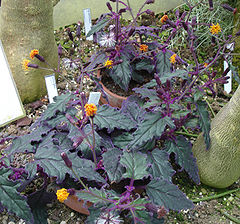Gynura
| Gynura subsp. var. | Velvet plant | |||||||||||||||||||||||||||||||||||||||||||||||||||||||
|---|---|---|---|---|---|---|---|---|---|---|---|---|---|---|---|---|---|---|---|---|---|---|---|---|---|---|---|---|---|---|---|---|---|---|---|---|---|---|---|---|---|---|---|---|---|---|---|---|---|---|---|---|---|---|---|---|

|
|
| ||||||||||||||||||||||||||||||||||||||||||||||||||||||
| ||||||||||||||||||||||||||||||||||||||||||||||||||||||||
Gynura is an Asian genus of the botanical family Asteraceae. [1], subfamily Asteroideae, tribe Senecioneae. The most known species is Gynura aurantiaca, so called because of the color of its orange inflorescences. This plant is also commonly known as "Purple Passion" because of the velvety purple leaves.
| Standard Cyclopedia of Horticulture |
|---|
|
Gynura (name refers to the tailed stigmas). Compositae. Tropical herbs, sometimes grown under glass for the large showy foliage. Rarely subshrubby: lvs. alternate, entire or lobed, numerous: heads discoid, the florets commonly all fertile, not very showy; involucre cylindrical or somewhat bell-shaped, the narrow bracts in about 1 series: achene narrow, 5-10-striate, with copious slender white pappus-bristles. The gynuras are attractive glasshouse herbs, usually requiring a moderately high temperature; prop, by cuttings. Genus allied to Senecio and Cineraria; of about 40 species in Trop. Afr., Asia, to Austral.
|
Cultivation
Propagation
Pests and diseases
Species
Species include:
- Gynura aurantiaca (ornamental potted plant)
- Gynura bicolor (Okinawa spinach; nutritious cooked vegetable)
- Gynura crepidioides (nutritious cooked vegetable)
- Gynura drymophila
- Gynura formosana
- Gynura nepalensis (cholesterol spinach; supposedly cholesterol-lowering)
- Gynura sarcobasis (Thickhead; formerly Crassocephalum & Gynura crepidioides; [2] Correct name is Crassocephalum sarcobasis.
- Gynura sarmentosa
- Gynura sarmentosa "Pink Ice"
- Gynura sarmentosa "Aureo-variegata"
Gallery
References
